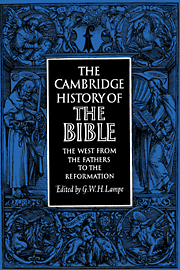Book contents
- Frontmatter
- I The Old Testament: Manuscripts, Text and Versions
- II The History of the Text and Canon of the New Testament to Jerome
- III Early Christian Book-Production: Papyri and Manuscripts
- IV Jerome
- V The Medieval History of the Latin Vulgate
- VI The Exposition and Exegesis of Scripture
- VII The ‘People's Bible’: Artists and Commentators
- VIII Bible Illustration in Medieval Manuscripts
- IX The Vernacular Scriptures
- X Erasmus in Relation to the Medieval Biblical Tradition
- Bibliography
- Notes on the Plates
- Index
II - The History of the Text and Canon of the New Testament to Jerome
Published online by Cambridge University Press: 28 March 2008
- Frontmatter
- I The Old Testament: Manuscripts, Text and Versions
- II The History of the Text and Canon of the New Testament to Jerome
- III Early Christian Book-Production: Papyri and Manuscripts
- IV Jerome
- V The Medieval History of the Latin Vulgate
- VI The Exposition and Exegesis of Scripture
- VII The ‘People's Bible’: Artists and Commentators
- VIII Bible Illustration in Medieval Manuscripts
- IX The Vernacular Scriptures
- X Erasmus in Relation to the Medieval Biblical Tradition
- Bibliography
- Notes on the Plates
- Index
Summary
THE TEXT
The aim and object of the textual critic is to deduce from all the available material what the original author wrote. None of the original manuscripts of the New Testament exists, and, until the age of printing began in the fifteenth century, all manuscripts were copied by hand. Mistakes arose inevitably in the process. The reader is challenged to copy out a page of the New Testament fairly rapidly without an error: mistakes were easier to make in the early days of the Church, when words were not separated in writing, and when punctuation and Greek breathings and accents were absent from the capital (uncial) letters employed. Alterations to the text during the process of transmission could be either accidental or intentional. By accident, words or lines were omitted by a scribe whose eye passed over one word or phrase to another similar to it (haplography) or they were written by him twice (dittography). The former error constantly occurred at the end of a sentence or a phrase, when the scribe's eye had left the original to concentrate on the copy, so that, of two phrases ending in a similar or identical way, one is omitted (homoioteleuton). Sometimes a scribe working in a scriptorium, and hearing the original text being read out, would be guilty of errors of ear rather than of eye; αi, εi, η are constantly confused; even ήμεĩs is written for υμεĩs, ‘we’ for ‘you’, cf. Col. i. 7. For the critic such errors have often a value, because, unless they are pure accidents that might happen to a number of scribes independently, they point to textual relationship: the more errors that one manuscript has in common with another, the greater is the probability of their affinity.
- Type
- Chapter
- Information
- The Cambridge History of the Bible , pp. 27 - 53Publisher: Cambridge University PressPrint publication year: 1969
- 1
- Cited by



